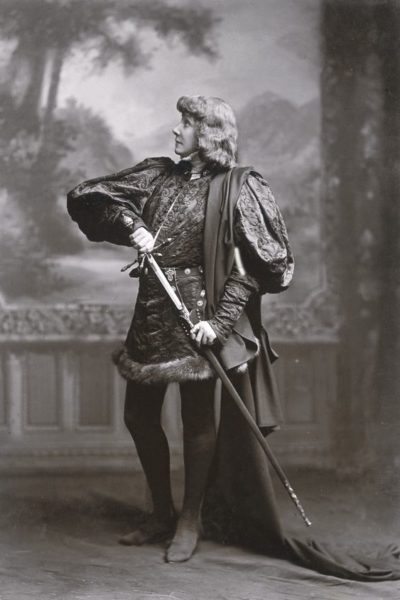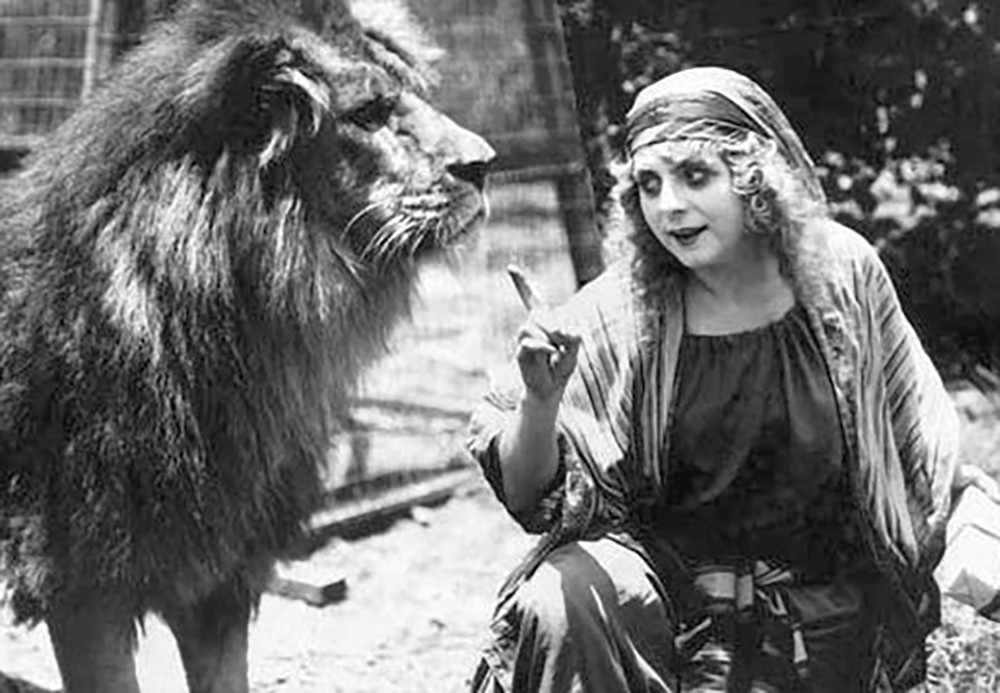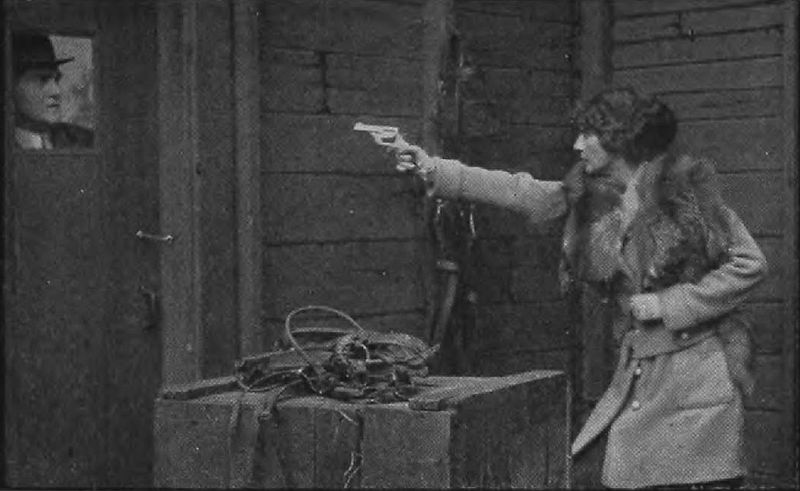“Within a sensational action-adventure framework of the sort generally associated with male heroics, serials gave narrative preeminence to an intrepid young heroine who exhibited a variety of traditionally “masculine” qualities: physical strength and endurance, self-reliance, courage, social authority and freedom to explore novel experiences outside the domestic sphere.”
— Melodrama and Modernity: Early Sensational Cinema and Its Contexts by Ben Singer
 Despite what some people apparently think, the action heroine predates Ellen Ripley by… oh, almost eight decades. What should likely be regarded as the first of its kind actually appeared just five years after the Lumiere brothers shocked the audiences with a train arriving at a station. It was called Le Duel d’Hamlet and was released in 1900, as part of a program at the Exposition Universelle in Paris that year. The film clocks in at just under two minutes, and is an excerpt from Shakespeare’s Hamlet, in particular the fencing scene with Laertes – it’s basically nothing but action! This is notable, not just for being the first filmed “version” of the play, but because the part of Hamlet is played by Sarah Bernhardt, at the time one of the most renowned stage actresses in France (or any other country).
Despite what some people apparently think, the action heroine predates Ellen Ripley by… oh, almost eight decades. What should likely be regarded as the first of its kind actually appeared just five years after the Lumiere brothers shocked the audiences with a train arriving at a station. It was called Le Duel d’Hamlet and was released in 1900, as part of a program at the Exposition Universelle in Paris that year. The film clocks in at just under two minutes, and is an excerpt from Shakespeare’s Hamlet, in particular the fencing scene with Laertes – it’s basically nothing but action! This is notable, not just for being the first filmed “version” of the play, but because the part of Hamlet is played by Sarah Bernhardt, at the time one of the most renowned stage actresses in France (or any other country).
However, the crown of the earliest “true” film action queen perhaps belongs to the little-known Gene Gauntier. She got her start in the first decade of the 20th century, before credits became established, which partly explains why her place in history has almost evaporated. She literally walked on to her first film set with no experience to become a stunt-woman, being thrown into 30-foot deep water – despite not being able to swim! While acting was not her sole talent – she wrote the scenario for a 1907 adaptation of Ben Hur, which ended up costing her studio $25,000 in a landmark copyright case – it was her role of “Nan, the Confederate Spy” which merits her claim to the title here. In 1909-10, the character appeared in The Girl Spy, The Girl Spy Before Vicksburg and The Further Adventures of the Girl Spy.
Similarly ground-breaking was What Happened to Mary – note, no question-mark, it being a statement rather than a question. This was the earliest motion picture serial made in the United States, the first of its 12 monthly episodes being released in July 1912. This was also a very early example of cross-promotion. The idea originated as, and was then tied to, a series of stories in Ladies’ World Magazine; these were left unfinished, as a contest for readers to submit their own endings. However, each episode stood alone, with titles such as The Escape from Bondage or A Race to New York.
The series helped make a star of Mary Fuller, who had previously appeared in 1910’s Frankenstein, the first cinematic adaptation of Mary Shelley’s story, playing the doctor’s fiancée. After Mary, she’d go on to further serial success with Dolly of the Dailies, which depicted the adventures of Dolly Desmond, lady reporter extraordinaire. In an October 1914 poll of stars in Motion Picture Magazine which garnered a total of 11 million votes, she finished third among actresses, behind only Clara Young and Mary Pickford. She was also a screenwriter, who had eight scripts turned into films between 1913 and 1915. But her career was basically over by 1917; she subsequently had more than one nervous breakdown and spent the last 26 years of her life in a psychiatric institution, before dying in 1973, all but forgotten.
Sadly, both these are now largely lost. Only a couple of episodes of Dolly survive, one discovered in New Zealand of all places (apparently, it was often the final worldwide stop for prints during the silent era) in 2010. That entry was #5, titled The Chinese Fan. In in, Dolly goes to Chinatown to review a play. Unfortunately, the brooch she is sporting is actually a Triad symbol, leading to her being kidnapped by a Chinese gang. However, this ordeal simply allows our heroine to help free a heiress, also abducted for the usual nefarious purposes of Chinese gangs from the era, fortuitously getting a scoop for her paper at the same time.
The popularity of Mary and Dolly led to a legion of imitators, including The Adventures of Kathlyn, which introduced the “cliff-hanger” concept to serials. It starred Kathlyn Williams, who like Fuller was a writer, and also directed on occasion. Kathlyn was a 13-episode series, which takes place in the Indian sub-continent, in the fictitious country of Allaha, as the heroine goes to rescue her kidnapped father from Oriental intrigue. While little remains of the series, or the feature version two years later, the novelization by Harold MacGrath is available through Project Gutenberg, and we have reviewed it here.

You will see her bound by fanatical natives on the top of a giant funeral pyre and watch the flames creeping ever nearer her helpless form. You will see her tied with thongs in a tiger trap as human bait for the blood thirsty beasts of the jungle. You will see her swimming for her life to escape a maddened water-buffalo in the black waters of a Bengal river. Time after time, in scene after scene, this actress takes her life in her hands and walks grimly up to the very jaws of death in order to portray with lifelike realism the actual adventures of MacGrath’s heroine.
— Advertising poster for The Adventures of Kathlyn
The series was ground-breaking in other ways, particularly its advertising. The film is credited by some as being the first use of a trailer: a short clip from the next episode shown at the end, to whet the audience’s appetite. Spin-off merchandising associated with it included a cocktail, face-power, perfume and more than one song. And like Mary, it was among the first examples of media cross-promotion, with the story being serialized in newspapers from Los Angeles to Boston. In Chicago, Kathlyn and Dolly ended up facing off directly. The former had her story serialized in the Chicago Tribune, the newspaper paying the then remarkable price of $12,000 for the rights – 10% of the cost of making the series, and about $300,000 in modern money. Following its success in boosting the publication’s circulation, its local rival the Evening American, under legendary mogul William Randolph Hearst, bought the rights to Dolly of the Dailies, in order to run its story there.
1914 saw action heroines become a veritable craze, giving us The Exploits of Elaine and The Perils of Pauline (both starring Pearl White), Lucille Love, Girl of Mystery (starring Grace Cunard) and The Hazards of Helen. White was perhaps the name most associated with serials in the public’s eye, appearing in half a dozen over the rest of the decade. [Though she was firmly based on the East coast, and apparently never even visited Hollywood] But Pauline remains perhaps the best known serial, with its simple yet open-ended plot. If Pauline Marvin (White) dies before she marries, she will not inherit her fortune; instead, it’ll go to her guardian, Koerner (Paul Panzer). No prizes for guessing where this leads. Repeatedly…
Grace Cunard was a particularly interesting character, who was a prolific writer, and co-directed many of her own adventures, alongside frequent co-star Francis Ford (the older brother of renowned Western director, John). Cunard created the character of “My Lady Raffles,” described as, “a jewel thief with a delightfully reckless charm,” and also played the Queen of the Apaches, a Robin Hood-like heroine, in the 1916 serial, The Purple Mask. The advertising for the latter series promised: “The most mysterious plot; the swiftest action; the most fascinating locale – Parisian high society and the Apache underworld; dare-devil stunts; romance, adventure – a true love-story”
“Miss Holmes is everywhere in the picture, flipping cars on fast moving trains, boarding engines and remaking train schedules after cutting into the train dispatcher’s wire from all sorts of remote mountain way stations; fording rivers up to her neck in icy water, and holding up members of the raiding gang at the point of her trusty automatic.”
— Reel Life, May 05, 1917
However, it was The Hazards of Helen which became the longest-running of these serials, with 119 episodes through February 1917. The first fifty or so episodes of Helen starred Helen Holmes, but when she left the studio, they turned to the woman generally recognized as Hollywood’s first stuntwoman, Rose Gibson (renaming her Helen Gibson, naturally!), who had occasionally doubled for Holmes. Gibson had first performed in a Wild West Show at age 17, but when her current employer suddenly closed, stranding the performers in California, she ended up working part-time in the fledgling movie industry. Her first billed role was in Ranch Girls on a Rampage, which is not as good as its title sounds.
Helen recounts the adventures of its titular heroine, a telegraph operator stationed at a remote outpost in the West, who saves the company from ruin and disaster on a near-weekly basis. There may have been some inspiration from Holmes herself, who was the daughter of a railroad engineer, and she also took a significant part in production behind the scenes. In a 1916 interview for The Green Book Magazine, she said, “If a photoplay actress wants to achieve real thrills, she must write them into the scenario herself. And the reason is odd: Nearly all scenario writers and authors for the films are men, and men usually won’t provide for a girl, things they wouldn’t do themselves. So if I want real thrilly action, I ask permission to write it in myself.”

Worth noting these early action heroine were not strictly limited to serials, however. The year also gave us the standalone short feature (1000 ft, which I think works out to about 14 minutes) When The Cartridges Failed. In this, Gertrude McCoy plays an office worker who stands in for the usual armed guard on a wage delivery. She has to defend the money from an attempted robbery, despite the revolver she was given having only two bullets loaded into it. While the movie itself is gone, the one still image which survives (above), suggests this may well be an early, standalone “girls with guns” film.
“I have always been afraid. But I would be ashamed to let fear rule me.” – Pearl White
These women didn’t just play daring heroines. Being an actor was a risky job in the early days, because it was a time before stands-in were at all common. If something dangerous needed to be done, it was usually the player who did it, and there was no respecting the gentler sex, when it came to embracing danger. For instance, in her diary entry for April 6th, 1914, Mary Fuller wrote, “They blew me up with a Black Hand bomb today, doing Dolly of the Dailies (No. 7). The charge of dynamite was very heavy. The shack was wrecked, my clothes were torn and blackened, and blood ran from a scalp wound,” adding almost laconically, “It was exciting. I hope my fans will like it.” She also almost drowned, filming a scene for Mary in which she played a mermaid.
Similarly, the Des Moines News in 1912 said admiringly of Kathlyn Williams, “She has never refused to risk her own safety for the sake of a good picture.” Her area of particular renown was working with animals, including big cats (as shown in the picture above), causing Kathlyn to be known as “the Unafraid”. Even before her serial, she required stitches in a head wound after a lion tore a gash in her scalp during the filming of Lost in the Jungle. The Los Angeles Times said of another Williams’ film, The Lady and the Tigers, “Miss Williams was required to enter the cage of three tigers lately brought from the jungle, which were untamed and didn’t know a moving-picture genius from a meat-pie.”
Injuries were common, though in the experience of Pearl White, they “never happened when I was doing what looked really dangerous… Why worry about the big things? It’s the little ones that get me.” But there was no shortage of major stunts done by these leading ladies. As an example, those performed by Helen Holmes included “riding a balky horse down a steep cliff and plunging into the river; dropping from an aerial steel cable onto the roof of a boxcar going 20 mph; leaping from a burning building; jumping from the roof of one moving train to another; and dropping from a trestle into an automobile.”
For real sangfroid though, it’s hard to beat Ruth Roland, star of 1919 series The Adventures of Ruth. According to her director there, George Marshall, “I used to shoot at her feet with real bullets. Didn’t bother her none.”
But it couldn’t last. From a modern perspective, the passing of the 19th amendment by Congress in 1919, giving women the right to vote, may have sapped the public’s drive for strong cinematic heroines. But for whatever reason, the genre died out almost entirely in the twenties. By 1936, the Los Angeles Times was able to proclaim, “There are no more serial queens…Helen Holmes, Pearl White and the others have long since retired, and the ladies of the serials now prefer to let their menfolk wear the pants.” It would be several more decades before anyone even remotely comparable would return to the screens in America.
Below, you’ll find a YouTube playlist including a number of the films discussed above, in chronological order. It starts with Sarah Bernhardt’s scene from Hamlet, then goes through Gene Gautier’s The Girl Spy Before Vicksburg, The Car of Death starring Helen Holmes, and the Chinese Fan episode of Mary Fuller’s Dolly of the Dailies, finishing with several parts of The Hazards of Helen, starring both Holmes and Helen Gibson.



















